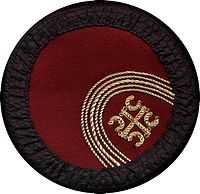Serbdom
Serbdom (Serbian: Српство) is an ambiguous term used by ethnic Serbs to denote a type of patriotism or solidarity of the Serbian people. It is distinguished from Serbian nationalism by lack of a political agenda and absence of antagonistic or aggressive attitudes. It is distinguished by devotion to Serbian culture, history and the Serbian Orthodox Church.
Term
Serbdom is a word used before the term "nationalism" (The term was coined by Johann Gottfried Herder (nationalismus) during the late 1770s.
History

"Whoever is a Serb and of Serb birth,
And of Serb blood and heritage,
And comes not to the Battle of Kosovo,
May he never have the progeny his heart desires,
Neither son nor daughter!
May nothing grow that his hand sows,
Neither dark wine nor white wheat!
And let him be cursed from all ages to all ages!"
Middle ages
The Battle of Kosovo in 1389 against the Ottoman Empire is a strong symbol for Serbdom.
Modern
At the turn of the 19th–20th centuries, many Serbian nationalist movements, such as Narodna Odbrana and Young Bosnia, were based more anti-imperialism (specially against Austro-Hungarian Empire) and secular Pan-Slavism than any religious identity; they included both Orthodox and Muslims, such as Muhamed Mehmedbašić, in their membership.[1][2] On the other side, the monarchist paramilitary movement Bela Ruka (created in 1912) had a more traditionalist approach, and by the 1920s its members became a prominent force in the First Yugoslavia after World War I.
Marko Miljanov's message to the Austrian ambassador to Montenegro: "Tell that Austrian deputy, to tell his Emperor, should God turn him over to good, to then unite the Serbdom: Bosnia and 'Erzegovina, Montenegro, Serbia and Old Serbia, and to make that the Serb Kingdom"
The renaissance of Serbian nationalism after three centuries of Ottoman control of the Balkans came at the time of the romantic-nationalist Revolutions of 1848 in Western Europe and the 19th-century expansion and rise of a great Slavic Orthodox power, the Russian Empire, which has designed itself as a protector (and later liberator) of Orthodox Christian peoples (among Serbs, Greeks, Montenegrins, Romanians, Bulgarians) on Ottoman lands.
Culture
Folk attire
- The Šajkača is a national hat for ethnic Serbs; it has its roots from the 18th century Serbian river fleet in the Habsburg military known as "Šajkaši" that fought Ottoman Turks around the Danube and Sava river. The remnants of the military spread the design in the villages and it became a hat of the peasants. The hat would in the Balkan Wars and after the First World War act as the official hat of the Royal Yugoslav Army. The elderly ethnic Serbs in Serbia and Bosnia and Herzegovina, especially in the villages, wear the hat on everyday basis. The Serbs of Montenegro use both the Šajkača and the Montenegrin hat, the Šajkača also being a political pro-Serb sign.

- The Montenegrin cap is a national hat for ethnic Serbs of Montenegro and in later times the self identifying Montenegrins, originally in the shape of a flat cylinder, having a red upper surface (called tepelak) not dissimilar to the Herzegovina and Lika caps. It was wholly red until Prince-Bishop Petar II Petrović Njegoš surrounded it with a black rim (called derevija),[3] and the definition given was as a sign of grief of occupied Kosovo. The Kosovo Myth was very popular in the old Montenegrin state. The enforcement of the cap upon the Montenegrin chieftains by Prince-Bishop Peter II Petrović-Njegoš was a mark of expression of then's dominating Serbian national identity.[4] The national telling recorded the most often version of the cap as following: the black wrapper was sign of grief for the once big Empire, the red the bloody defeat at the Battle of Kosovo[5] and the five small stripes on the top represent the remaining remains of the once greater Serbian realm,[6] which became increasingly popular amongst the common folk during the reign of Prince Danilo I Petrović-Njegoš. Within the stripes is angled a six star, representing the last free part, Montenegro, shining upon the fallen and conquered.[7] Worn by the rulers and chieftains, the version with the Four Ocil symbol in the star's place had become across the years with growth of nationalism excessively popular amongst the ordinary people, the symbol of the Serbian Orthodox Church, which effectively worked on maintaining and raising the national identity.
See also
- Serbenda
- Rise of nationalism under the Ottoman Empire
- Gazimestan Speech
- Breakup of Yugoslavia
References
- ↑ Feature Articles: The Balkan Causes of World War One, from firstworldwar.com, 11 August 2001
- ↑ Mohammed Mehmedbasic bio at Harold B. Lee Library website
- ↑ "Crna Gora i Crnogorci" by Vuk Stefanović Karadžić
- ↑ "O najstarijoj kapi kod Jugoslovena..." by Miodrag Vlahović
- ↑ Crna Gora... Narodni život i običaji" by Andrija Jovićević
- ↑ "Crnogorska muška kapa" by Zorica Radulović
- ↑ "Fizicki lik i izgled Njegosa" by Jovan Vukmanović
External links
- Serbian National League
- Fierce Serb Nationalism Pervades Student Foes of Belgrade Leader, The New York Times, 10 December 1996
- Antisemitism in Serbia, Stephen Roth Institute
- Serbia's Reluctant Path to Catharsis - Transitions On Line
- Steven W. Sowards "Serbian nationalism from the "Nacertanije" to the Yugoslav Kingdom"
- Scaife, Robert. "Serbian Culture of Victimization and Nationalism in a Post-Cold War Europe" Paper presented at the annual meeting of the Southern Political Science Association, Inter-Continental Hotel, New Orleans, LA, Jan 09, 2005 Online <.PDF>. 2008-04-23
- Postwar Serbian Nationalism and the Limits of Invention - NICK MILLER Cambridge Studies